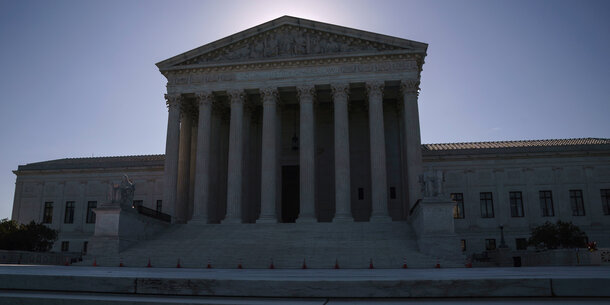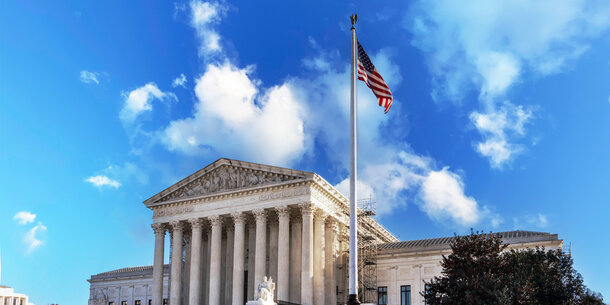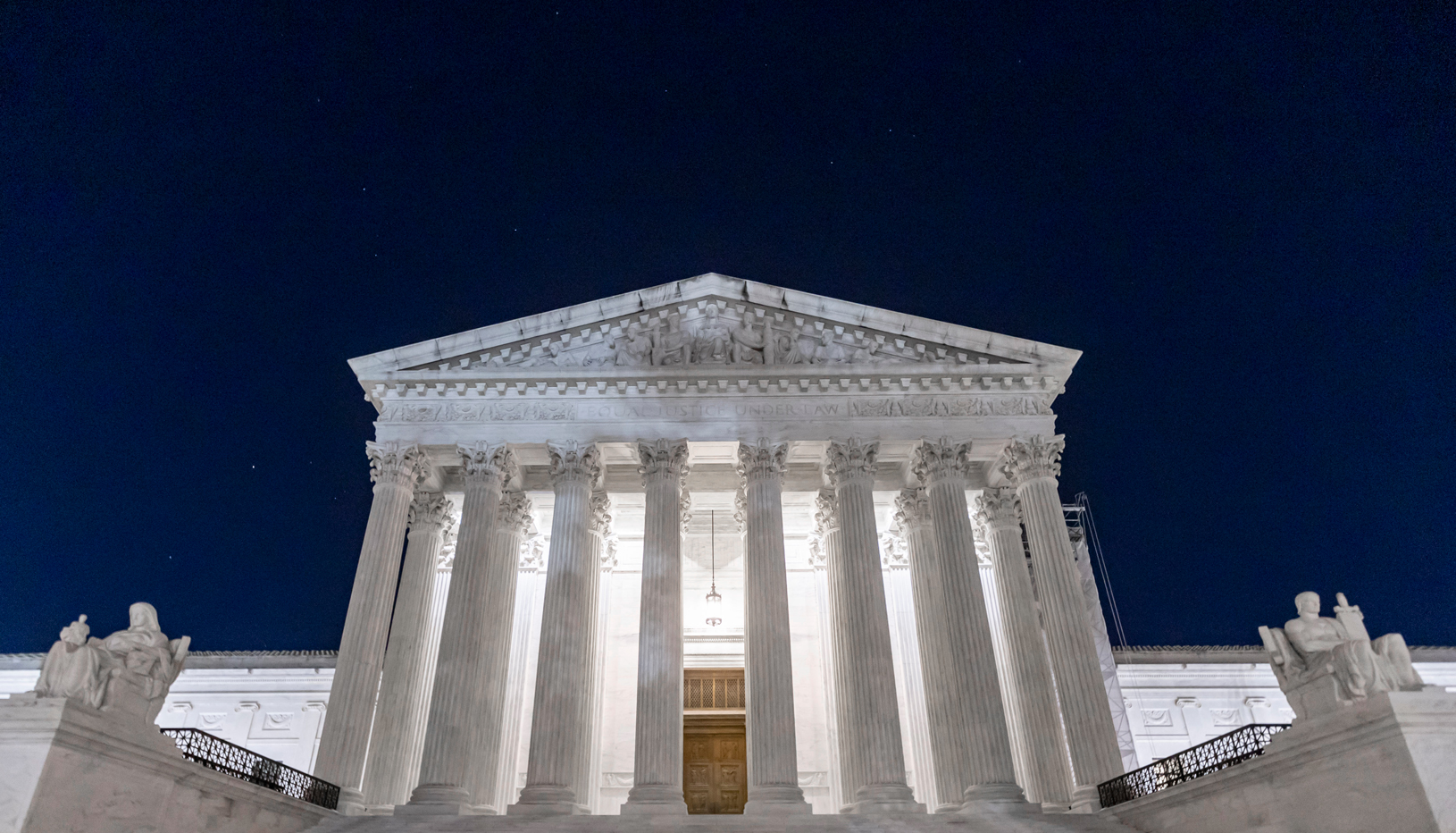Introduction
Today’s Supreme Court has assumed a degree of power and importance that would have been unrecognizable in the founding era.footnote1_Wmw0fTxDTcmkE3oFMR9PoQEqda1gqf1A4HMIRnC-hKI_aysFGFmiYHJP1 Professor Jamal Greene captured this development succinctly in testimony to the Presidential Commission on the Supreme Court: “A starkly different political and legal landscape in a nation of 330 million has the potential to turn on the views of a single person. That single person is unelected, is one of only nine, can be confirmed by a bare and strictly partisan majority of the U.S. Senate, plays a major role in deciding what cases they hear, can potentially remain in office for 40 or 50 years, and can, in effect, choose the ideology of their replacement, who may in turn hold office for another 40 or 50 years under like conditions. In constitutional cases, the decisions the Court reaches are effectively unreviewable except by the Court itself, amendment of the federal Constitution having become effectively defunct. . . . The Founders did not gift us this constellation of features.” Presidential Commission on the Supreme Court of the United States, Closing Reflections on the Supreme Court and Constitutional Governance, July 20, 2021 (statement of Jamal Greene, Dwight Professor of Law, Columbia Law School), 6, https://www.whitehouse.gov/wp-content/uploads/2021/07/Greene-Testimony.pdf. A recent cascade of ethics scandals has laid bare a system in which justices wield tremendous power for decades with little accountability,footnote2_0UI44mcJhCbT5YrLyhWikc-EDqKgAQaxxUnL3yKWU_ze3lcoxZbT9V2 Joshua Kaplan, Justin Elliott, and Alex Mierjeski, “Clarence Thomas Had a Child in Private School. Harlan Crow Paid the Tuition,” ProPublica, May 4, 2023, https://www.propublica.org/article/clarence-thomas-harlan-crow-private-school-tuition-scotus; Emma Brown, Shawn Boburg, and Jonathan O’Connell, “Judicial Activist Directed Fees to Clarence Thomas’s Wife, Urged ‘No Mention of Ginni,’” Washington Post, May 4, 2023, https://www.washingtonpost.com/investigations/2023/05/04/leonard-leo-clarence-ginni-thomas-conway/; Mattathias Schwartz, “Jane Roberts, Who Is Married to Chief Justice John Roberts, Made $10.3 Million in Commissions from Elite Law Firms, Whistleblower Documents Show,” Forbes, April 28, 2023, https://www.businessinsider.com/jane-roberts-chief-justice-wife-10-million-commissions-2023–4; Charlie Savage, “Head of a Major Law Firm Bought Real Estate From Gorsuch,” New York Times, April 25, 2023, https://www.nytimes.com/2023/04/25/us/neil-gorsuch-property-sale.html; Joshua Kaplan, Justin Elliott, and Alex Mierjeski, “Clarence Thomas and the Billionaire,” ProPublica, April 6, 2023, https://www.propublica.org/article/clarence-thomas-scotus-undisclosed-luxury-travel-gifts-crow; Jodi Kantor and Jo Becker, “Former Anti-Abortion Leader Alleges Another Supreme Court Breach,” New York Times, November 19, 2022, https://www.nytimes.com/2022/11/19/us/supreme-court-leak-abortion-roe-wade.html; and Adam Liptak, “Justice Thomas Ruled on Election Cases. Should His Wife’s Texts Have Stopped Him?,” New York Times, March 25, 2022, https://www.nytimes.com/2022/03/25/us/supreme-court-clarence-thomas-recusal.html. while the Court’s rulings are increasingly unmoored from democratic values and the principle of judicial restraint.footnote3_LNheS9dEYy9WCGEatlqSCRIVpmIdkKPZ2fChsSNzM_s8vZ5YJAa1Nv3 Stephen Jessee, Neil Malhotra, and Maya Sen, “A Decade-Long Longitudinal Survey Shows That the Supreme Court Is Now Much More Conservative Than the Public,” Proceedings of the National Academy of Sciences 119, no. 24 (June 6, 2022), https://www.pnas.org/doi/10.1073/pnas.2120284119; and Mark A. Lemley, “The Imperial Supreme Court,” Harvard Law Review 136, no. 1 (November 2022): 97–118, https://harvardlawreview.org/2022/11/the-imperial-supreme-court/. At the same time, polarization among the political parties and the justices themselves has dramatically increased the partisan stakes of the confirmation process, leading to a broken system.footnote4_3jhayl64vqTPsJ3rt41EDzNGgiZqLn679VA6YSvCBw8_u0KBp3BcLOKI4 Alan I. Abramowitz and Steven Webster, “The Rise of Negative Partisanship and the Nationalization of U.S. Elections in the 21st Century,” Electoral Studies 41 (2016): 12, https://www.sciencedirect.com/science/article/abs/pii/S0261379415001857; Neal Devins and Lawrence Baum, “Split Definitive: How Party Polarization Turned the Supreme Court into a Partisan Court,” Supreme Court Review 2016 (January 30, 2017): 301–65, https://doi.org/10.1086/691096; and Amelia Thomson-DeVeaux and Laura Bronner, “The Supreme Court Divide Hasn’t Been This Sharp in Generations,” FiveThirtyEight, July 5, 2022, https://fivethirtyeight.com/features/the-supreme-courts-partisan-divide-hasnt-been-this-sharp-in-generations/. Public trust in the Court is at a historical low.footnote5_aTHCOlQGtnf28MZ5ZF7ssKKgYoj8pL4LaVkDlqRJyZs_tcJvRBxldqU95 Jeffrey M. Jones, “Supreme Court Trust, Job Approval at Historical Lows,” Gallup, October 6, 2022, https://news.gallup.com/poll/402044/supreme-court-trust-job-approval-historical-lows.aspx.
For all these reasons, there are growing calls for reform. Proposals range from creating an ethics code to expanding the Court to stripping its jurisdiction. One of the most popular options would also be among the most transformative: establishing 18-year terms and regularized appointments for justices. Under this system, justices would sit in staggered terms of active service on the Court, such that a new vacancy would open every two years. Each president would have two, and only two, appointments during a four-year term.
This paper explains how such a reform would work, why it would bolster the Court’s legitimacy, and how to transition from the current system. It also discusses how the core elements of this reform could be adopted by statute, consistent with the Constitution, by establishing the role of “senior justice.” Among other things, senior justices would hear cases by designation on the lower courts, step in to hear cases on the Supreme Court in the event of a recusal or unexpected vacancy, and assist with the management and administration of the federal courts. This framework is similar to the existing system of senior judges that has been in place for more than a century and has applied to the justices since 1937.footnote6_U1hhcBnGIAzY2veETOrgAjfbai6bDcYXD2A7Y3xGyQ_xKOcmno3ENN26 Marin K. Levy, “The Promise of Senior Judges,” Northwestern University Law Review 115, no. 4 (January 17, 2021): 1240–42, https://scholarlycommons.law.northwestern.edu/nulr/vol115/iss4/5/. However, rather than leave the timing of senior status up to the justices’ discretion, under this reform Congress would create a schedule by which justices assume senior status automatically after 18 years of active service on the Court.
The case for reform is compelling. On average, justices today sit on the bench for more than a decade longer than their predecessors did as recently as the 1960s.footnote7_7YK1fJgeQNCzWmUrjHWQ96pju5mN5LuqzSUbMtAlBaQ_qpfSaK6SzO827 Steven G. Calabresi and James Lindgren, “Term Limits for the Supreme Court: Life Tenure Reconsidered,” Harvard Journal of Law and Public Policy 29, no. 3 (May 2006): 771, https://papers.ssrn.com/sol3/papers.cfm?abstract_id=701121. Post-2006 calculations on file with the Brennan Center. Several justices now on the Court are likely to hold office over as many as nine presidential terms. Unbounded tenure allows a single justice to shape the direction of the law for generations, without regard for the evolving views and composition of the electorate. It puts justices in an elite and unaccountable bubble for decades. No other major democracy in the world provides life tenure for high court judges who hear constitutional cases.footnote8_yVgNxFxvN5agTKHFAd8D3B1xjXUTElKiMuteo9sYQbg_nazpOelNYXyF8 Calabresi and Lindgren, “Term Limits,” 819; Presidential Commission, Closing Reflections (statement, Greene), 23; and Presidential Commission on the Supreme Court of the United States, Term Limits and Turnover on the U.S. Supreme Court: A Comparative View, July 20, 2021 (written testimony of Tom Ginsburg, Leo Spitz Professor of Law, University of Chicago Law School, and research fellow, American Bar Foundation), 3, https://www.whitehouse.gov/wp-content/uploads/2021/07/Ginsburg-Testimony.pdf.
With today’s intense ideological polarization, every Supreme Court vacancy also takes on monumental stakes. Exercises of raw power have replaced long-established constitutional norms, upending the confirmation process.footnote9_JnrOQ4L14iAD7DN4ICRZFA1olKmlPAsNay1WODqN06Y_kh4SvtIliGEI9 Michael J. Gerhardt and Richard W. Painter, “Majority Rule and the Future of Judicial Selection,” Wisconsin Law Review 2017, no. 2 (May 2017): 270–75, https://wlr.law.wisc.edu/wp-content/uploads/sites/1263/2017/05/Gerhardt-Painter-Final.pdf. This constitutional hardballfootnote10_IzIB4bpR1L7lqDlOeLAZ-H3f92JFDnsOBT0LLx6w3b0_mjHobOfclaQk10 Joseph Fishkin and David E. Pozen, “Asymmetric Constitutional Hardball,” Columbia Law Review 118 (2018): 921, https://papers.ssrn.com/sol3/papers.cfm?abstract_id=3126344. was illustrated most notoriously when Republican senators refused to consider President Barack Obama’s March 2016 nomination of Merrick Garland, claiming that it was too close to the presidential election, only to rush through a vote for Amy Coney Barrett in October 2020, when early voting in that year’s presidential election had already started.
One result of these dynamics has been that presidents have had starkly disparate imprints on the Court. President Donald Trump appointed three justices in four years, whereas Presidents Bill Clinton, George W. Bush, and Barack Obama each appointed two justices in eight years. This wide variation, as well as its impact on the development of American law, is impossible to square with principles of democratic legitimacy.
By contrast, with 18-year active terms and regularized appointments, every president would have an equal imprint on the Court during a four-year term. Such a system would enhance the democratic link between the Court and the public, making the institution more reflective of changing public values while preserving judicial independence.
This reform would also encourage a better-functioning and less politically charged confirmation process. Shorter terms would lower the stakes of each nomination, while regularized appointments would both encourage compromise and allow for public accountability in the event of confirmation impasses. Regularized appointments would also eliminate the destabilizing impact of late-term vacancies because an unexpected death or retirement would not create a new seat to fill; instead, a senior justice would temporarily step in. And this reform would ensure that no individual holds largely unchecked power for decades at a time.
Broad swaths of Americans support term limits for justices. Since 2022, several polls have found that more than two-thirds of the public are in favor of this reform, including more than three-quarters of Democrats, two-thirds of independents, and more than half of Republicans. This bipartisan support is long-standing: since at least 2014, polls have consistently shown supermajority support for term limits (see appendix).
A broad array of scholars likewise support term limits. When the National Constitution Center convened separate groups of conservative and progressive scholars in 2020 to draft their ideal constitutions, both proposed 18-year terms.footnote11_McLnyz22OWIaRTtVm1pTlfiLXlSvm7Hz7zGWb4E0_kkokiwoTAWqi11 Caroline Fredrickson, Jamal Greene, and Melissa Murray, The Progressive Constitution, National Constitution Center, accessed March 7, 2023, https://constitutioncenter.org/news-debate/special-projects/constitution-drafting-project/the-progressive-constitution; and Robert P. George et al., The Conservative Constitution, National Constitution Center, accessed March 7, 2023, https://constitutioncenter.org/news-debate/special-projects/constitution-drafting-project/the-conservative-constitution. Comparative constitutional law scholars have reached the same conclusion, acknowledging that “were we writing the United States Constitution anew, there is no way we would adopt the particular institutional structure that we have for judicial tenure. No other country has true lifetime tenure for its justices, and for good reason.” Presidential Commission, Term Limits and Turnover (written testimony, Ginsburg), 2. The Presidential Commission on the Supreme Court, which was created by President Joe Biden to evaluate options for Supreme Court reform, described term limits as enjoying “considerable, bipartisan support.”footnote12_bvrGAGFASrBlu1FQDVByafbNAb8WZr59qxT2OlxBx8_uIpe59RX9TYD12 Presidential Commission on the Supreme Court of the United States, Final Report, December 2021, 111, https://www.whitehouse.gov/wp-content/uploads/2021/12/SCOTUS-Report-Final-12.8.21–1.pdf.
The Constitution gives Congress wide latitude to determine the Supreme Court’s structure and responsibilities. Congress should use its power now to reform the Supreme Court.
End Notes
-
footnote1_Wmw0fTxDTcmkE3oFMR9PoQEqda1gqf1A4HMIRnC-hKI_aysFGFmiYHJP
1
Professor Jamal Greene captured this development succinctly in testimony to the Presidential Commission on the Supreme Court: “A starkly different political and legal landscape in a nation of 330 million has the potential to turn on the views of a single person. That single person is unelected, is one of only nine, can be confirmed by a bare and strictly partisan majority of the U.S. Senate, plays a major role in deciding what cases they hear, can potentially remain in office for 40 or 50 years, and can, in effect, choose the ideology of their replacement, who may in turn hold office for another 40 or 50 years under like conditions. In constitutional cases, the decisions the Court reaches are effectively unreviewable except by the Court itself, amendment of the federal Constitution having become effectively defunct. . . . The Founders did not gift us this constellation of features.” Presidential Commission on the Supreme Court of the United States, Closing Reflections on the Supreme Court and Constitutional Governance, July 20, 2021 (statement of Jamal Greene, Dwight Professor of Law, Columbia Law School), 6, https://www.whitehouse.gov/wp-content/uploads/2021/07/Greene-Testimony.pdf. -
footnote2_0UI44mcJhCbT5YrLyhWikc-EDqKgAQaxxUnL3yKWU_ze3lcoxZbT9V
2
Joshua Kaplan, Justin Elliott, and Alex Mierjeski, “Clarence Thomas Had a Child in Private School. Harlan Crow Paid the Tuition,” ProPublica, May 4, 2023, https://www.propublica.org/article/clarence-thomas-harlan-crow-private-school-tuition-scotus; Emma Brown, Shawn Boburg, and Jonathan O’Connell, “Judicial Activist Directed Fees to Clarence Thomas’s Wife, Urged ‘No Mention of Ginni,’” Washington Post, May 4, 2023, https://www.washingtonpost.com/investigations/2023/05/04/leonard-leo-clarence-ginni-thomas-conway/; Mattathias Schwartz, “Jane Roberts, Who Is Married to Chief Justice John Roberts, Made $10.3 Million in Commissions from Elite Law Firms, Whistleblower Documents Show,” Forbes, April 28, 2023, https://www.businessinsider.com/jane-roberts-chief-justice-wife-10-million-commissions-2023–4; Charlie Savage, “Head of a Major Law Firm Bought Real Estate From Gorsuch,” New York Times, April 25, 2023, https://www.nytimes.com/2023/04/25/us/neil-gorsuch-property-sale.html; Joshua Kaplan, Justin Elliott, and Alex Mierjeski, “Clarence Thomas and the Billionaire,” ProPublica, April 6, 2023, https://www.propublica.org/article/clarence-thomas-scotus-undisclosed-luxury-travel-gifts-crow; Jodi Kantor and Jo Becker, “Former Anti-Abortion Leader Alleges Another Supreme Court Breach,” New York Times, November 19, 2022, https://www.nytimes.com/2022/11/19/us/supreme-court-leak-abortion-roe-wade.html; and Adam Liptak, “Justice Thomas Ruled on Election Cases. Should His Wife’s Texts Have Stopped Him?,” New York Times, March 25, 2022, https://www.nytimes.com/2022/03/25/us/supreme-court-clarence-thomas-recusal.html. -
footnote3_LNheS9dEYy9WCGEatlqSCRIVpmIdkKPZ2fChsSNzM_s8vZ5YJAa1Nv
3
Stephen Jessee, Neil Malhotra, and Maya Sen, “A Decade-Long Longitudinal Survey Shows That the Supreme Court Is Now Much More Conservative Than the Public,” Proceedings of the National Academy of Sciences 119, no. 24 (June 6, 2022), https://www.pnas.org/doi/10.1073/pnas.2120284119; and Mark A. Lemley, “The Imperial Supreme Court,” Harvard Law Review 136, no. 1 (November 2022): 97–118, https://harvardlawreview.org/2022/11/the-imperial-supreme-court/. -
footnote4_3jhayl64vqTPsJ3rt41EDzNGgiZqLn679VA6YSvCBw8_u0KBp3BcLOKI
4
Alan I. Abramowitz and Steven Webster, “The Rise of Negative Partisanship and the Nationalization of U.S. Elections in the 21st Century,” Electoral Studies 41 (2016): 12, https://www.sciencedirect.com/science/article/abs/pii/S0261379415001857; Neal Devins and Lawrence Baum, “Split Definitive: How Party Polarization Turned the Supreme Court into a Partisan Court,” Supreme Court Review 2016 (January 30, 2017): 301–65, https://doi.org/10.1086/691096; and Amelia Thomson-DeVeaux and Laura Bronner, “The Supreme Court Divide Hasn’t Been This Sharp in Generations,” FiveThirtyEight, July 5, 2022, https://fivethirtyeight.com/features/the-supreme-courts-partisan-divide-hasnt-been-this-sharp-in-generations/. -
footnote5_aTHCOlQGtnf28MZ5ZF7ssKKgYoj8pL4LaVkDlqRJyZs_tcJvRBxldqU9
5
Jeffrey M. Jones, “Supreme Court Trust, Job Approval at Historical Lows,” Gallup, October 6, 2022, https://news.gallup.com/poll/402044/supreme-court-trust-job-approval-historical-lows.aspx. -
footnote6_U1hhcBnGIAzY2veETOrgAjfbai6bDcYXD2A7Y3xGyQ_xKOcmno3ENN2
6
Marin K. Levy, “The Promise of Senior Judges,” Northwestern University Law Review 115, no. 4 (January 17, 2021): 1240–42, https://scholarlycommons.law.northwestern.edu/nulr/vol115/iss4/5/. -
footnote7_7YK1fJgeQNCzWmUrjHWQ96pju5mN5LuqzSUbMtAlBaQ_qpfSaK6SzO82
7
Steven G. Calabresi and James Lindgren, “Term Limits for the Supreme Court: Life Tenure Reconsidered,” Harvard Journal of Law and Public Policy 29, no. 3 (May 2006): 771,
https://papers.ssrn.com/sol3/papers.cfm?abstract_id=701121. Post-2006 calculations on file with the Brennan Center. -
footnote8_yVgNxFxvN5agTKHFAd8D3B1xjXUTElKiMuteo9sYQbg_nazpOelNYXyF
8
Calabresi and Lindgren, “Term Limits,” 819; Presidential Commission, Closing Reflections (statement, Greene), 23; and Presidential Commission on the Supreme Court of the United States, Term Limits and Turnover on the U.S. Supreme Court: A Comparative View, July 20, 2021 (written testimony of Tom Ginsburg, Leo Spitz Professor of Law, University of Chicago Law School, and research fellow, American Bar Foundation), 3, https://www.whitehouse.gov/wp-content/uploads/2021/07/Ginsburg-Testimony.pdf. -
footnote9_JnrOQ4L14iAD7DN4ICRZFA1olKmlPAsNay1WODqN06Y_kh4SvtIliGEI
9
Michael J. Gerhardt and Richard W. Painter, “Majority Rule and the Future of Judicial Selection,” Wisconsin Law Review 2017, no. 2 (May 2017): 270–75, https://wlr.law.wisc.edu/wp-content/uploads/sites/1263/2017/05/Gerhardt-Painter-Final.pdf. -
footnote10_IzIB4bpR1L7lqDlOeLAZ-H3f92JFDnsOBT0LLx6w3b0_mjHobOfclaQk
10
Joseph Fishkin and David E. Pozen, “Asymmetric Constitutional Hardball,” Columbia Law Review 118 (2018): 921, https://papers.ssrn.com/sol3/papers.cfm?abstract_id=3126344. -
footnote11_McLnyz22OWIaRTtVm1pTlfiLXlSvm7Hz7zGWb4E0_kkokiwoTAWqi
11
Caroline Fredrickson, Jamal Greene, and Melissa Murray, The Progressive Constitution, National Constitution Center, accessed March 7, 2023, https://constitutioncenter.org/news-debate/special-projects/constitution-drafting-project/the-progressive-constitution; and Robert P. George et al., The Conservative Constitution, National Constitution Center, accessed March 7, 2023, https://constitutioncenter.org/news-debate/special-projects/constitution-drafting-project/the-conservative-constitution. Comparative constitutional law scholars have reached the same conclusion, acknowledging that “were we writing the United States Constitution anew, there is no way we would adopt the particular institutional structure that we have for judicial tenure. No other country has true lifetime tenure for its justices, and for good reason.” Presidential Commission, Term Limits and Turnover (written testimony, Ginsburg), 2. -
footnote12_bvrGAGFASrBlu1FQDVByafbNAb8WZr59qxT2OlxBx8_uIpe59RX9TYD
12
Presidential Commission on the Supreme Court of the United States, Final Report, December 2021, 111, https://www.whitehouse.gov/wp-content/uploads/2021/12/SCOTUS-Report-Final-12.8.21–1.pdf.








